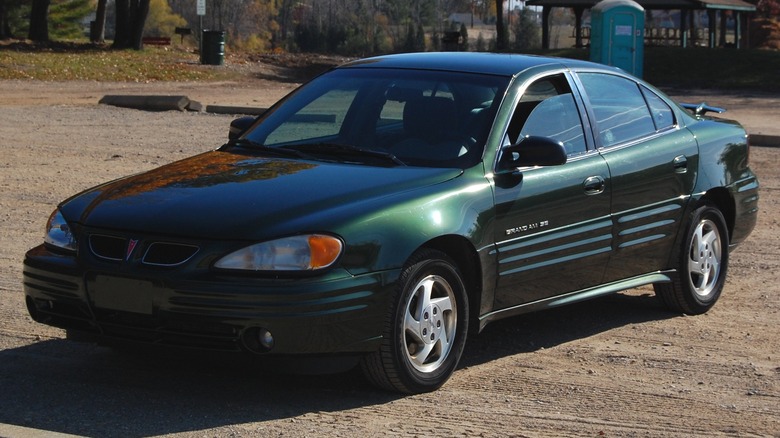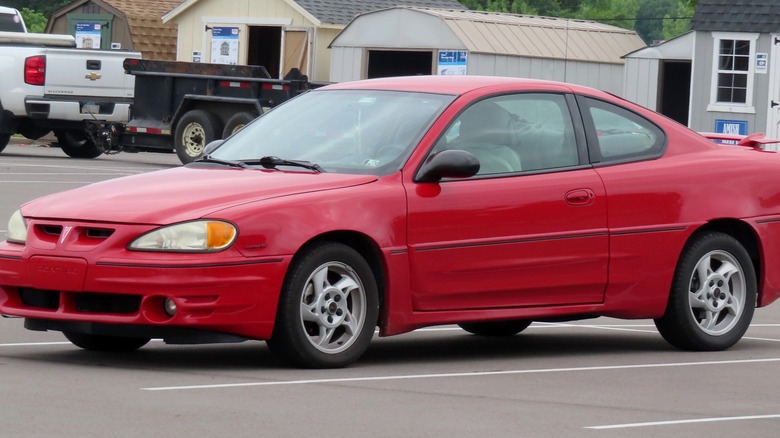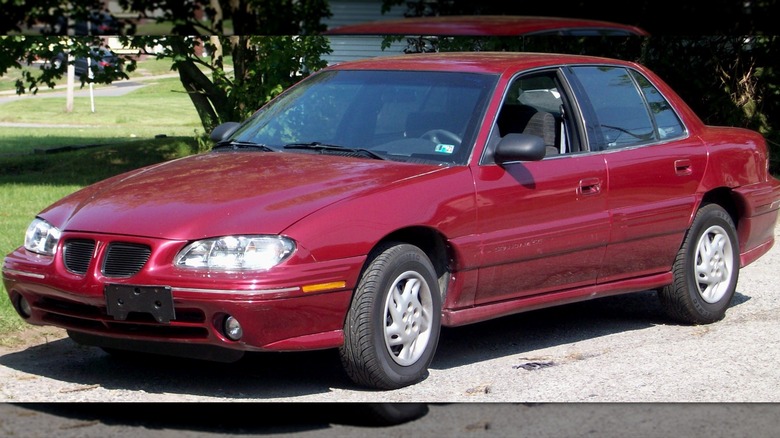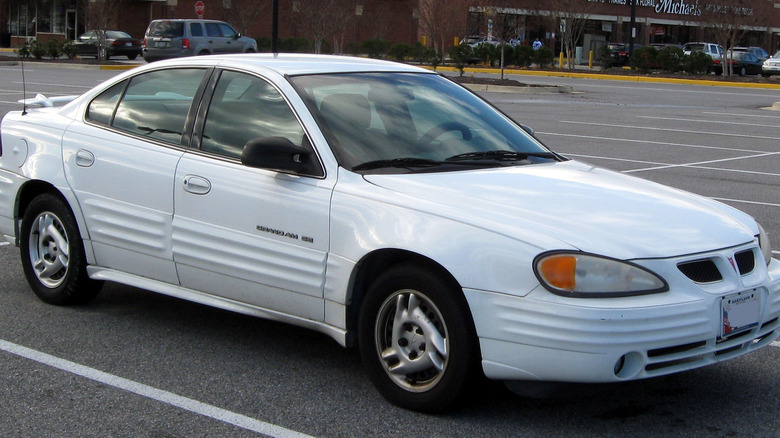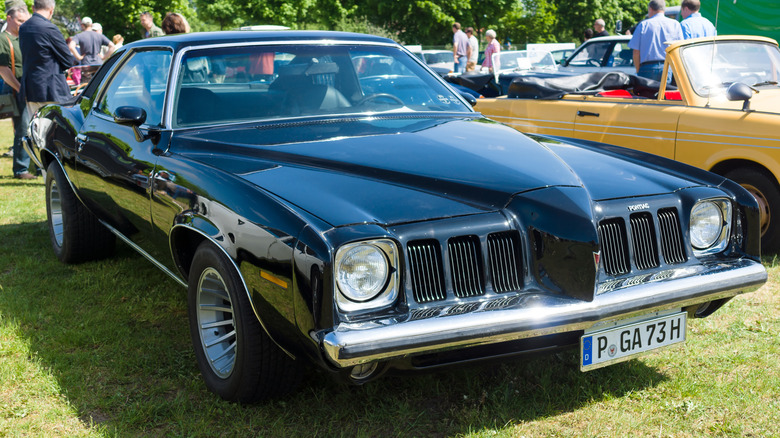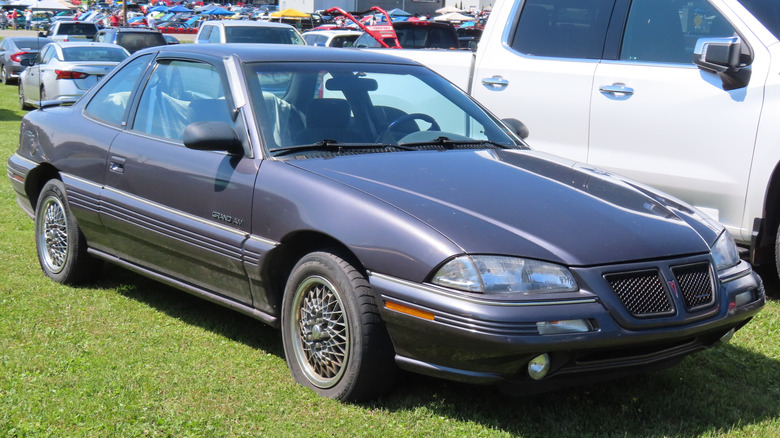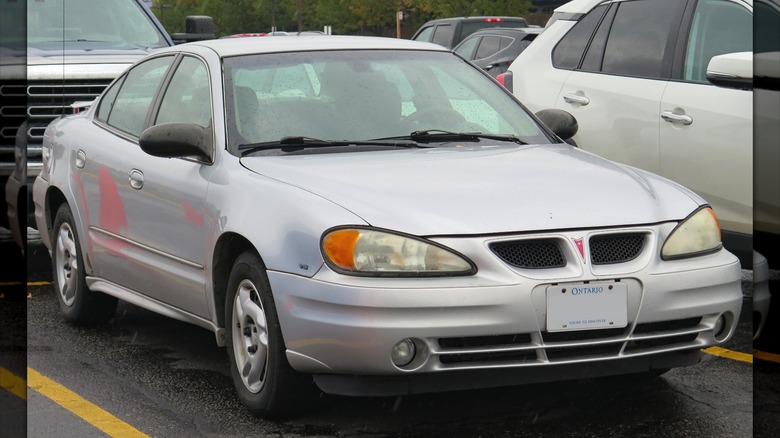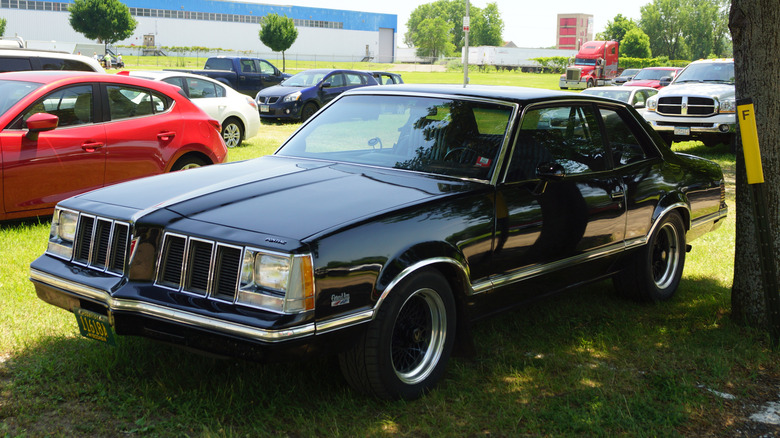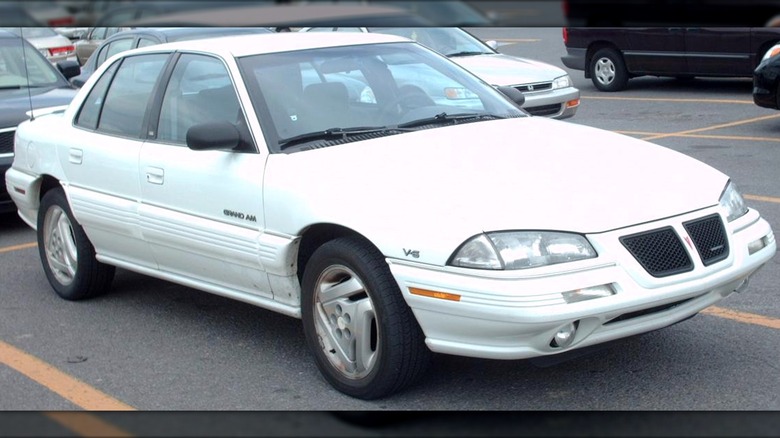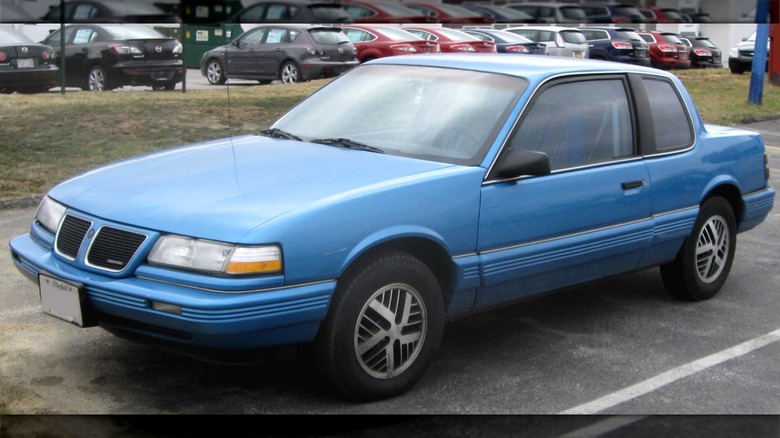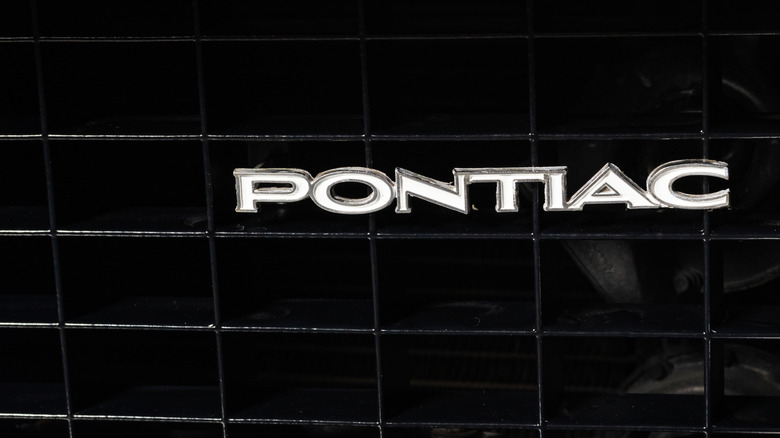The Best Years For Pontiac Grand Am (And Some To Avoid)
Pontiac's Grand Am started life as an interesting attempt to combine the Trans Am's performance and Grand Prix's luxury — with a peppering of European style — and create an all-new type of car that gave owners the best of both worlds. It was a bit of a dud the first time around and fared even worse when Pontiac gave the concept another shot in the late 1970s. It wasn't until 1985 and the debut of the front-wheel-drive Grand Am that Pontiac really struck gold.
Pontiac built five generations of the Grand Am, with the third, fourth, and fifth generations likely the ones you'll have seen on the roads. These were popular cars, selling around 200,000 units annually for many years. The front-wheel-drive models aren't particularly exciting, but their huge production numbers make them easy to find on the used market — and very affordable, too.
Used front-wheel-drive Grand Ams can be had for well under $3,000, with some being as affordable as $1,200. With prices this low, the question becomes: Is it worth agonizing over long-term reliability if all you need is a cheap fix for personal mobility? Only you can answer that, and we'll leave you to ponder it as you go through our list of the best and worst years for the Pontiac Grand Am.
[Image by Taubin via Flickr | Cropped and scaled | CC BY 2.0]
Best: 2005 Pontiac Grand Am
The 2005 Pontiac Grand Am was the last-ever model year for the nameplate, and it went out on a high note, at least in the reliability stakes. Most of the 102 complaints on the NHTSA website involve a faulty ignition switch, which tends to turn off randomly (sometimes after going over bumps). It's an issue that plagues most of the final generation of Grand Ams, and for which GM announced a recall in 2014.
Beyond the iffy ignition, the 2005 Grand Am seems generally reliable, at least judging by owner complaints. Now, whether this is because GM fixed the problems — such as failure-prone intake manifold gaskets — that plagued earlier fifth-gen Grand Ams or simply because the fifth-gen Grand Am didn't sell well, and thus there weren't that many owners to lodge complaints, is a whole other matter.
Despite that caveat, we still think buying the youngest Grand Am you possibly can is a good idea. Sure, 2005 is pretty much 20 years ago now, but an '05 Grand Am may just have lower mileage and less wear and tear than older models. It may not make a huge difference, but anything that tilts the odds in your favor helps. And you won't be paying a huge premium for the privilege of a slightly newer car, either: a four-door SE should only set you back around $2,600, based on Kelley Blue Book estimates.
[Image by MercurySable99 via Wikimedia Commons | Cropped and scaled | CC BY-SA 4.0]
Best: 1998 Pontiac Grand Am
The final year of the fourth-generation Grand Am has the second-lowest number of complaints on the NHTSA website, with only 184 complaints logged. This doesn't necessarily prove it's significantly more reliable than its predecessors, admittedly, but we'd consider it a positive sign nonetheless — at least, in the context of the Pontiac Grand Am.
As with many Grand Ams, owner complaints involve one of two aspects: the electrical system or the engine — and, in some cases, both. The ignition system randomly shuts the car off, while the anti-theft system seems to trigger unnecessarily. Engine issues involve the all-too-familiar gaskets, which seem to pose problems for four- and six-cylinder engines. None of these will be cheap to fix, but you're also not going to pay much for a 1998 Grand Am: Kelley Blue Book considers $1,700 or thereabouts a fair price for most trim levels, meaning you could very well ditch your 1998 Grand Am if (or when) it blows a gasket.
The sequential fuel-injected V6 available in the later fourth-gen Grand Am isn't anything to shout about, and its 155 hp pales compared to the 175 hp from the high-output four-cylinder available earlier on in this generation, but let's be real: You're probably not looking for excitement with a Grand Am. Buying a later-model fourth-generation should get you an engine with lower mileage, and that's the best reason to avoid going too far back.
[Image by MercurySable99 via Wikimedia Commons | Cropped and scaled | CC BY-SA 4.0]
Avoid: 1999-2001 Pontiac Grand Am
This three-year stretch of Grand Ams seems like the worst of them all, judging by owner complaints on the NHTSA website. The 1999 Grand Am leads the way, with the NHTSA logging 909 complaints, with the following years close behind.
The ignition problem we mentioned for the 2005 Grand Am likely had its start with this batch of cars, with all three years recording a high number of complaints about difficulties starting, ignitions suddenly turning off while driving, and more than a few residual issues with GM's PassLock security that carried over from the previous generation. But that's not all: The intake gaskets were an issue, with failed gaskets leaking coolant and potentially damaging the engine. Owners were also critical of the brakes, with one of the more common complaints involving calipers that didn't release fully.
1999 Grand Ams also seem to have had many issues with the front suspension, with a noticeably high rate of broken front springs and struts. Last are the exterior lights, namely the hazard and turn signals: Owners of all three years, especially 2000 and 2001 Grand Ams, had a ton problems with them. Some noted that the lights wouldn't turn off, some complained that they wouldn't turn on, and others claimed that the lights would turn on randomly.
Only if you know what you're doing: 1973-1975 Pontiac Grand Am
The first-generation Pontiac Grand Am is an entirely different beast from the front-wheel-drive family car most of you will likely be familiar with. Built on GM's A-body platform, the early Grand Ams were likely the closest the nameplate ever got to muscle car status, with rear-wheel drive and an optional 250-hp 455 cubic inch V8 under the hood.
The first-generation Grand Am is something of a rare car, at least compared to its successors. Pontiac built around 150,000 units over three years, and while that's nowhere near as limited as some of Pontiac's rarest muscle cars, it's still a small enough run to push prices well into five figures when these come up for sale. Even 400 cubic inch Grand Ams command prices north of $15,000, at least at the time of writing.
If you want a '70s muscle car, but don't want any of the obvious choices, a first-gen Grand Am might be just the ticket. If that's what you're thinking, you're probably also willing to live with classic car quirks and put in the work to keep it on the road, so raw reliability isn't as big of a concern. Anyone who just wants a simple car to get from A to B in, though, shouldn't even consider one of these.
Avoid: 1992-1993 Pontiac Grand Am
The first few years of the fourth-gen Grand Am may seem like a good buy based on NHTSA complaints, but the nature of most of the complaints paints a different picture. Most issues involve the engine, with faults ranging from blown head gaskets and overheating to far more serious cylinder head cracks. Regular — and preventative — maintenance may help with the former, but cracked cylinder heads are a whole different matter.
Judging by owner reports on the NHTSA website, cracked cylinder heads mostly involve the 2.3-liter Quad 4 engine, so you may want to steer clear of this particular engine if you're seeking an early-1990s Grand Am. That said, the question we posed in the intro rears its head again here: How long do you need to run a $1,200 car? If you only need a quick fix, the potential for a cracked cylinder head isn't too bad; if you want something that could last longer, V6-equipped Grand Ams may be the better choice — if you have to get a Grand Am, that is. The seventh-generation Toyota Corolla, which we rate quite highly, only costs a bit more.
Engine issues aren't the only problems with the early '90s Grand Ams, though. Owners report that the electrics have an unfortunate tendency to catch on fire like the Pontiac Fiero, and while it doesn't seem widespread enough to be dangerous, it's probably not a risk worth taking.
[Image by MercurySable99 via Wikimedia Commons | Cropped and scaled | CC BY-SA 4.0]
Best: 2002-2004 Pontiac Grand Am
The 2002 to 2004 Pontiac Grand Ams don't differ too much from the 2005 Grand Am in terms of the problems they face, but there's a lot more evidence of these faults posing headaches to owners. The ignition switch has proven troublesome over the years, with faults including turning off while driving — hopefully addressed under recall in the past. The intake manifold gaskets also fail, as they tend to do on most Grand Ams.
The electrical components aren't entirely trouble-free, either, with the NHTSA website logging complaints related to failed security systems preventing owners from starting the car and indicator lights failing intermittently. Electricals can be a headache to address, but they're also probably not entirely ruinous faults either. These are 20-year-old, $2,500 cars we're talking about here, after all.
While the evidence we can gather suggests that the 2005 Pontiac Grand Am is probably the best buy of all the later Grand Ams — which is why it gets its own section — early-2000s Grand Ams are still worth considering. The 2002 Grand Am may be the most compelling of the three, with lower prices — around $2,000 for most models — offering decent savings over newer examples and possibly helping to make up for some of the woes you may face in the long run. You may also want to look for the Ram Air-equipped 2003 Grand Am GT, which has a 175 hp engine.
[Image by Elise240SX via Wikimedia Commons | Cropped and scaled | CC BY-SA 4.0]
Not for everyone: 1978-1980 Pontiac Grand Am
Pontiac's first Grand Am was a flop, but the company took another stab at the concept in 1978 with the second-generation Grand Am. Pontiac based the car on the fourth-generation Pontiac Grand Prix, with upgrades like improved handling (courtesy of stiffer springs and larger anti-roll bars), different styling, and a revised interior to differentiate.
Sadly, while reviewers of the time appreciated Pontiac's second stab at the Grand Am, buyers didn't. Pontiac only sold 18,141 units over the second-generation car's three-year production run — making it even rarer than the first-generation Grand Am. Its lack of appeal seems to extend to the used car market: Few of these come up for sale, with usually reliable price-tracking services barely having any data for the second-generation Grand Am. A good-condition example sold for around $20,000 on Bring a Trailer in 2024, but that's probably not the norm.
These are allegedly simple and reliable cars that are relatively easy to keep going, at least as far as late-1970s cars go. They're perhaps not the worst car from this era you could get, but their rarity and age still make them hard to recommend to the general buyer, and we'd recommend not spending too much time looking for one of these.
[Image by Greg Gjerdingen via Wikimedia Commons | Cropped and scaled | CC BY 2.0]
Avoid: 1995-1997 Pontiac Grand Am
The middle years of the fourth-generation Grand Am introduced a seemingly new problem for contemporary owners to deal with, and for modern owners to worry about. The anti-theft systems of the 1996 and 1997 Grand Ams tend to fail for whatever reason, locking legitimate owners out and stopping them from starting their cars.
Some owner complaints on the NHTSA website state that the problem persisted even after changing instrument clusters, while others went through three ignition lock cylinders within the same number of years trying to address the fault. Beyond the anti-theft system, you also have the typically problematic head and intake gaskets, which shouldn't surprise you if you've made it this far down the list. The gasket failures likely go hand-in-hand with all the overheating problems owners report, although it's not entirely easy to determine if the overheating is due to poor maintenance or a fundamental flaw.
Other issues are also worth pointing out. Airbags are troublesome across this stretch, with 1995 Grand Ams not deploying airbags in crashes while 1996 and 1997 models would sometimes deploy them at the most minor bump. 1995 Grand Am owners don't seem to have had as many complaints about the anti-theft system, but the electrics ended up posing a wholly different problem: fire. More than a few owners had their ignition system go up in flames, for which GM issued a recall in 2000.
Consider a newer model: 1985-1991 Pontiac Grand Am
Pontiac's third attempt at the Grand Am is the start of what most buyers will think of when they see the name Grand Am: A front-wheel drive city runabout that would eventually sell hundreds of thousands of units a year. Built on the then-new N-body platform, the third-generation Grand Am debuted in 1985, unfortunately with GM's infamously weak 2.5-liter four-cylinder Iron Duke engine under the hood.
Despite the uninspiring engine, the third time proved to be the charm for Pontiac. The company built around 100,000 units per year for the first few years, climbing to an impressive 200,000-plus units from 1987 to 1990. Pontiac had updated the Grand Am's engine options by the late 1980s, too, with a 165-hp turbo 2.0-liter and 150-hp 2.3-liter Quad 4 available — these are the engines you'll want to keep an eye out for if you're buying a third-gen Grand Am.
Objective reliability data is hard to come by for these, as the NHTSA's complaints system only really got going later in the 1990s. While that might be a drawback, the upside is that third-gen Grand Ams are cheap: J.D. Power estimates you'll pay around $1,125 for the cooler-than-you-remember 1991 model, for example. Spare parts seem easy to come by, too, so you could conceivably keep a $1,000 third-gen Grand Am going for a while more. Whether that's the smartest move is another story.
Methodology
The primary source for our recommendations is the NHTSA website, specifically the owner complaints for the various Grand Am Model years it's logged. While it's not a perfect indicator, we find it's a good way of gauging the general reliability of a car or model year. The nature of the issues is also important, of course, as some faults like crack-prone engine blocks are far more serious — and, likely, more expensive to fix — than iffy power windows or floppy sun visors.
Manufacturer recalls, as ever, also play a part in our recommendations. However, we opted not to put too much stock into them as even the newest Grand Am is going to be 20 years old soon, with the most recent recall happening 10 years ago. Replacement parts may well have failed again in the interim, so it's going to be up to you to make sure that any Grand Am you're buying is in good enough condition to be a daily driver.
That said, it's worth reiterating that the Grand Am nameplate's long life means that there are more than a few model years — or entire generations — where owner complaints are likely not at all representative of the ownership experience. But rather than avoid these model years altogether, we opted to go for a more general approach with the first few generations, making recommendations based on their age and the potential pitfalls of old cars.
